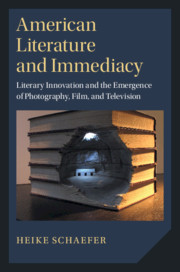 American Literature and Immediacy
American Literature and Immediacy Book contents
- American Literature and Immediacy
- Cambridge Studies in American Literature and Culture
- American Literature and Immediacy
- Copyright page
- Dedication
- Contents
- Acknowledgements
- The Quest for Immediacy in American Literature and Media Culture
- Part I Literary Immediacy and Photography
- Part II Literary Immediacy and the Cinema
- Part III Literary Immediacy and Television
- Chapter 7 Being There: Television’s Aesthetics of Immediacy
- Chapter 8 For Real? The Critique of TV Culture in the Short Fiction of Robert Coover and David Foster Wallace
- Chapter 9 “Nothing Happens Until It Is Consumed”: The Remediation of TV Images in Don DeLillo’s Novel Mao II
- Chapter 10 Fiction in the Age of Television
- Still in Pursuit
- Notes
- Bibliography
- Index
- Series page
Chapter 7 - Being There: Television’s Aesthetics of Immediacy
from Part III - Literary Immediacy and Television
Published online by Cambridge University Press: 19 December 2019
- American Literature and Immediacy
- Cambridge Studies in American Literature and Culture
- American Literature and Immediacy
- Copyright page
- Dedication
- Contents
- Acknowledgements
- The Quest for Immediacy in American Literature and Media Culture
- Part I Literary Immediacy and Photography
- Part II Literary Immediacy and the Cinema
- Part III Literary Immediacy and Television
- Chapter 7 Being There: Television’s Aesthetics of Immediacy
- Chapter 8 For Real? The Critique of TV Culture in the Short Fiction of Robert Coover and David Foster Wallace
- Chapter 9 “Nothing Happens Until It Is Consumed”: The Remediation of TV Images in Don DeLillo’s Novel Mao II
- Chapter 10 Fiction in the Age of Television
- Still in Pursuit
- Notes
- Bibliography
- Index
- Series page
Summary
The chapter defines TV’s immediacy effects. Television started out as a live medium. Although shows were soon pre-produced and recorded, an aesthetic of liveness, retained by shooting sitcoms and talk shows in front of studio audiences, has remained integral to TV culture. It sets TV apart from earlier visual media, particularly film, and is pivotal for the medium’s reality effects. Although “television” means to “see at a distance,” the initial promise of TV was that it would erase the distance between the viewers and the depicted events. Because event, transmission, and reception occur simultaneously during a live broadcast, it possesses not only temporal immediacy but also evokes a sense of spatial proximity and actuality. TV live coverage seems to bring the world home or to transport the viewers to the site of action. By presenting on- and off-screen worlds as directly connected, live TV blurs the boundary between public and private spheres, between fiction and fact, and creates the impression that the viewers participate in the broadcasted events. Since American TV is a commercial medium, the cultural dominance of TV results in a pervasive commodification of experience.
- Type
- Chapter
- Information
- American Literature and ImmediacyLiterary Innovation and the Emergence of Photography, Film, and Television, pp. 173 - 183Publisher: Cambridge University PressPrint publication year: 2020


